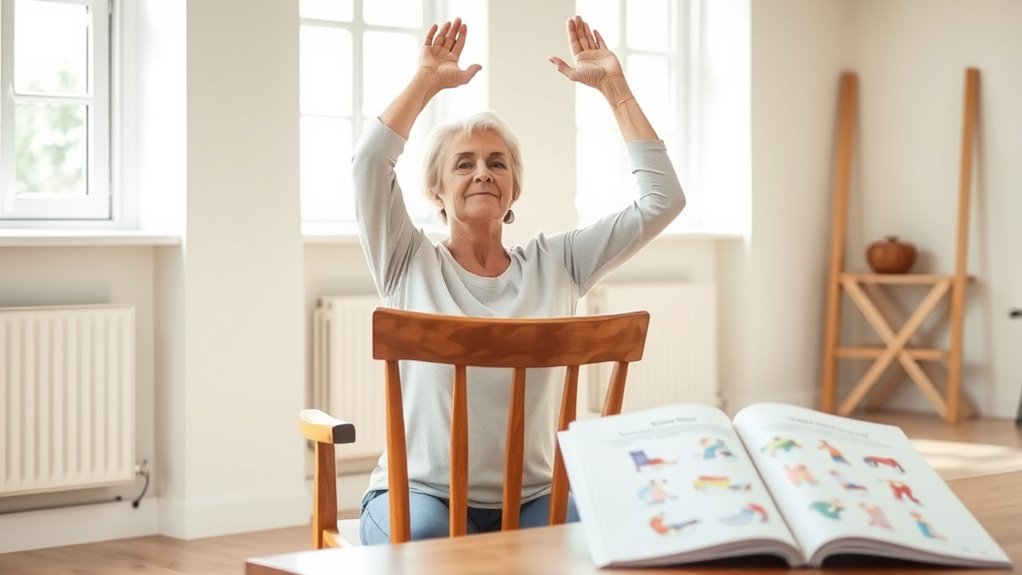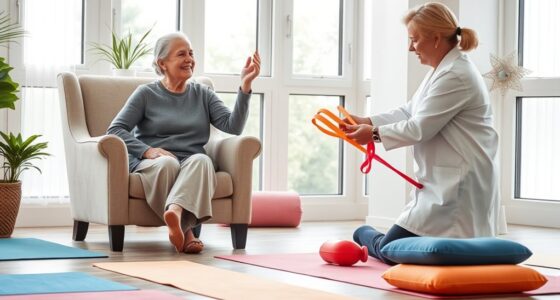Looking for a chair yoga routine video and printable guide? You’ll find easy-to-follow videos and printable resources that help you improve flexibility, strength, and relaxation—all from your chair. These guides are perfect for all ages and mobility levels, offering gentle stretches, breathing exercises, and safety tips. Incorporate warm-ups, cool-downs, and daily practice routines to boost your well-being. Keep exploring to discover more ways to make chair yoga a regular part of your routine.
Key Takeaways
- Find reputable chair yoga routine videos on platforms like YouTube for guided practice.
- Download printable guides that include step-by-step instructions for safe, effective chair yoga sessions.
- Look for resources that incorporate warm-up, main movements, breathing, and cool-down exercises.
- Choose videos and guides suitable for all mobility levels, especially beginners or those with limited mobility.
- Ensure the materials emphasize safety tips, proper posture, and modifications for a personalized practice.
Benefits of Chair Yoga for All Ages
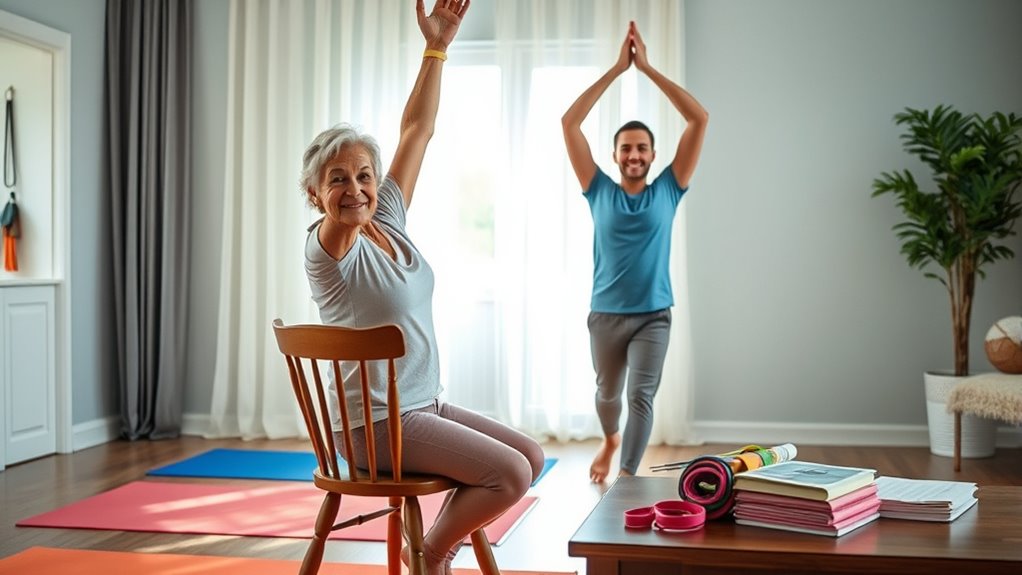
Chair yoga offers numerous benefits for people of all ages, making it a versatile and accessible form of exercise. When you practice chair yoga, you improve flexibility, strength, and balance without needing to leave your seat. The health benefits are significant—you can reduce stress, ease joint pain, and boost circulation. Whether you’re young or elderly, chair yoga helps enhance your overall well-being by encouraging gentle movement that’s easy on your body. It’s especially helpful if you have limited mobility or are recovering from an injury. Regular practice can also promote better posture and mental clarity. Additionally, chair yoga can be adapted to incorporate Free Floating techniques, making it even more customizable to individual needs. Because it’s adaptable and requires minimal space, chair yoga is an inclusive way to stay active and improve your health at any age.
Preparing Your Space and Setting Up

Creating a comfortable and safe environment is essential before starting your chair yoga routine. Start by choosing furniture that provides stable support, such as a sturdy chair without wheels, with a comfortable seat height. Clear the surrounding area of clutter to prevent accidents and allow free movement. Adjust the ambient lighting to be soft and calming, avoiding harsh or overly bright lights that can cause strain. Natural light is ideal if available, but if not, use warm, diffused lighting to create a relaxing atmosphere. Ensure your chair is positioned on a flat surface, with enough space around it for arm movements. Properly setting up your space helps you focus, stay safe, and fully enjoy your yoga session. Additionally, understanding precious metals investment assets can enhance your overall financial wellness, even as you focus on your physical health.
Warm-Up Stretches to Start Your Routine
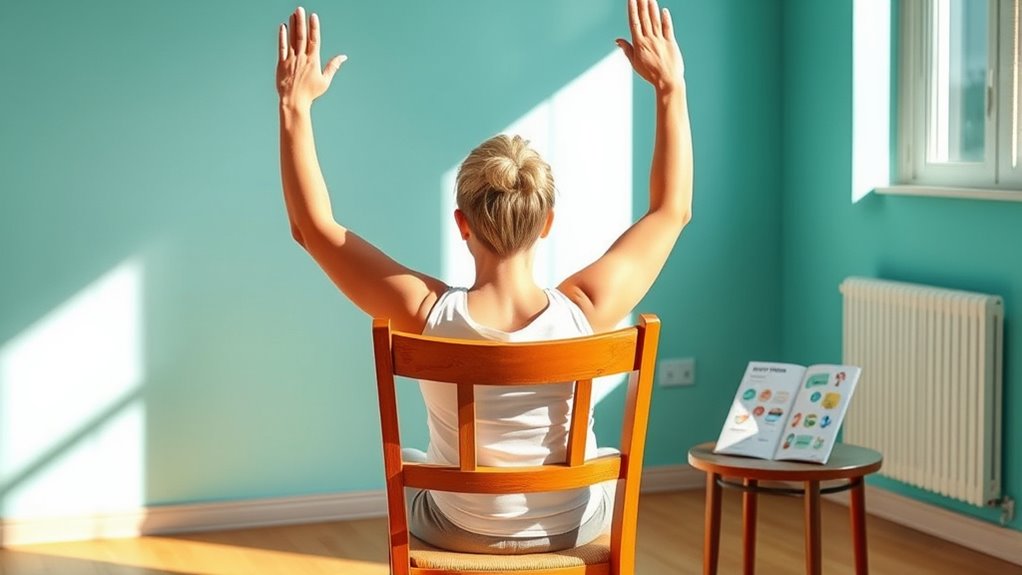
To effectively prepare your body for the session, start with gentle warm-up stretches that loosen tight muscles and increase circulation. Begin with seated meditation to center yourself and focus on your breath, helping you relax and become present. Use chair yoga props like cushions or blocks if needed to support comfortable posture. Gentle neck rolls and shoulder shrugs loosen tension in key areas, while seated spinal twists promote flexibility. Incorporate arm stretches to warm up your shoulders and upper back. These warm-up stretches prepare your muscles for more targeted poses later. Remember, moving mindfully during these initial stretches helps prevent strain and sets a calm, focused tone for your entire chair yoga routine. Incorporating mindful breathing during these stretches can further enhance your mental clarity and overall relaxation.
Upper Body Poses for Flexibility and Relaxation

Focusing on upper body poses can considerably enhance your flexibility and promote relaxation. Shoulder stretches are a great way to release tension and improve arm flexibility. Sit upright with your feet flat on the floor and gently roll your shoulders backward in slow circles. Reach your right arm across your chest, using your left hand to pull it closer, feeling the stretch across your shoulder and upper arm. Switch sides and repeat. You can also clasp your hands behind your back, lifting your arms slightly to open up your chest and shoulders. These poses help loosen tight muscles, reduce stress, and increase mobility. Incorporating these simple movements into your routine can make a significant difference in your overall flexibility and relaxation. Additionally, understanding anime culture and storytelling can enrich your appreciation for animated works that often feature expressive motion and emotional depth.
Lower Body Movements to Strengthen and Stretch
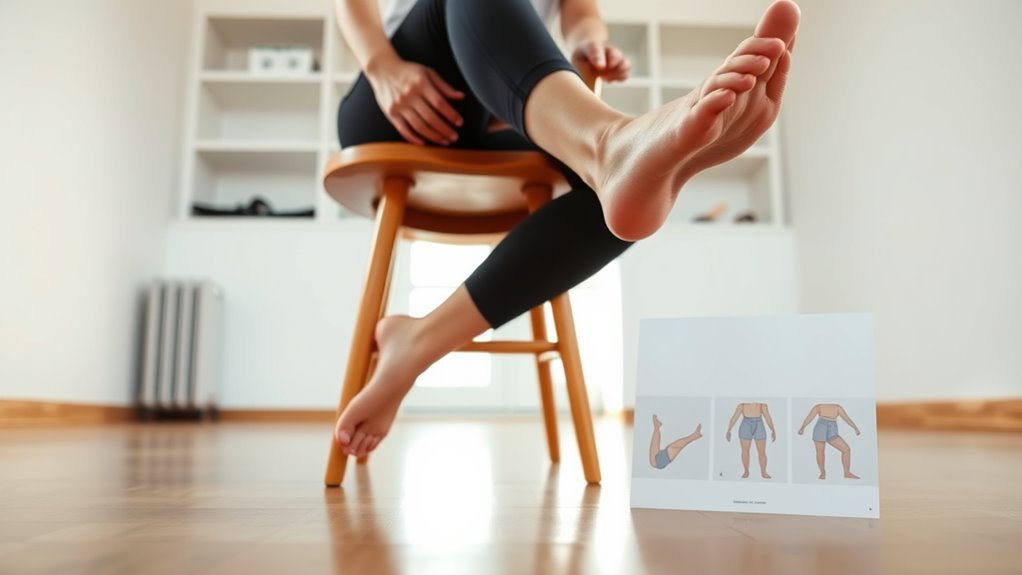
Building on your upper body stretches, incorporating lower body movements can boost both strength and flexibility. Focus on hip openers and hamstring stretches to enhance mobility and reduce stiffness. Sit tall and gently open your hips by crossing one ankle over the opposite knee, then lean forward slightly for a deep hip opener. To stretch your hamstrings, extend one leg straight with your heel on the floor and reach toward your toes. Repeat on the other side for balanced flexibility. Engaging in these movements supports holistic development by integrating physical, emotional, and cognitive growth.
Breathing Exercises to Enhance Calmness
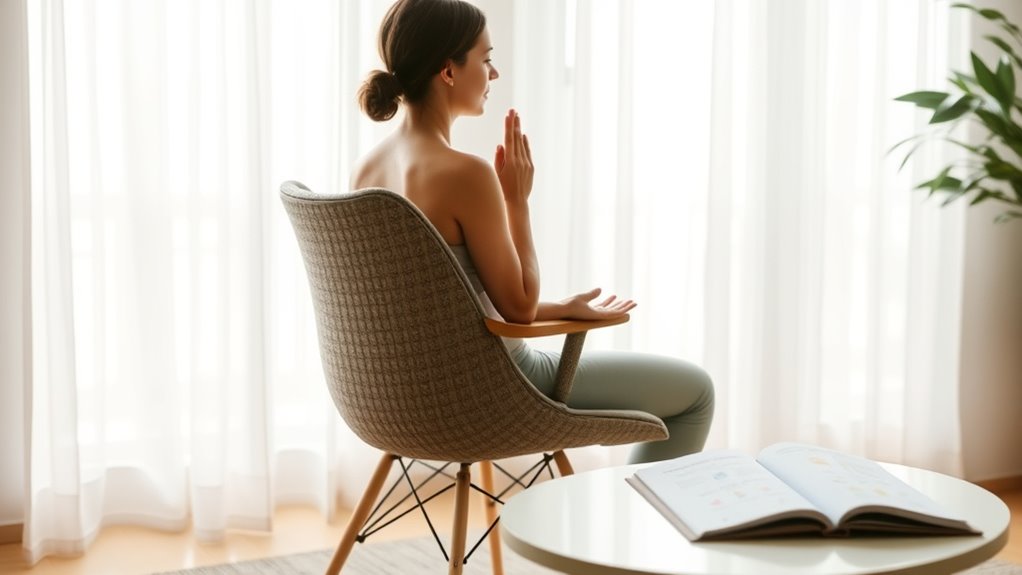
Incorporating breathing exercises into your chair yoga routine can substantially enhance your sense of calm and relaxation. One effective method is deep diaphragmatic breathing, where you breathe deeply into your belly rather than your chest. Focus on slow, controlled inhales through your nose, filling your lungs fully, then exhale gently through your mouth. Combining this with mindfulness meditation helps you stay present and attentive to each breath, reducing stress. Practice these breathing techniques for a few minutes daily to promote mental clarity and emotional balance. As you deepen your awareness of your breath, you’ll notice a gradual decrease in tension and anxiety. Utilizing analytical thinking during your practice can help you better assess your progress and identify areas for improvement. With regular practice, these exercises become a powerful tool to foster tranquility and inner peace during your chair yoga sessions.
Cool-Down and Gentle Stretching
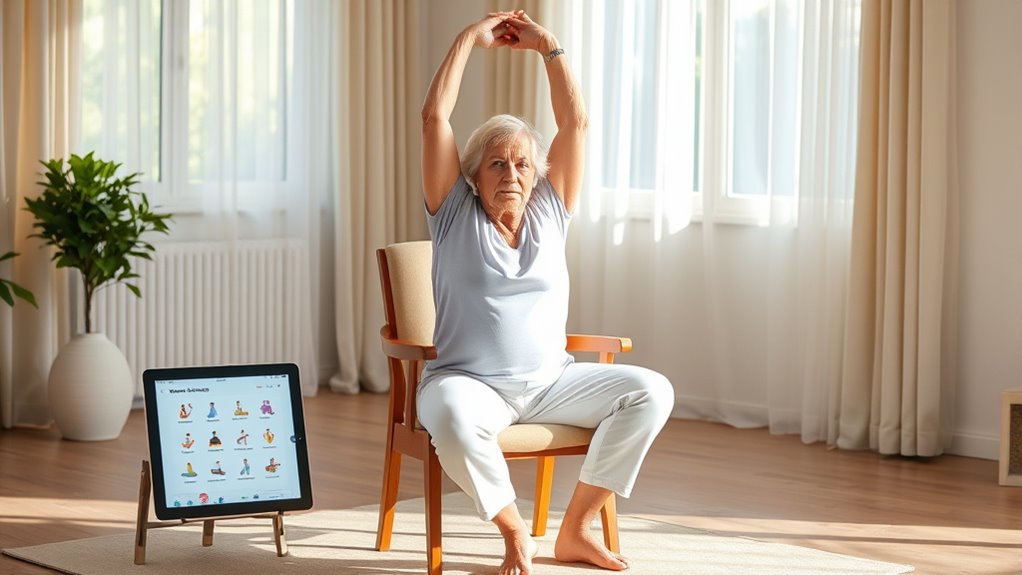
After your main routine, it’s important to focus on gentle stretch techniques that release tension and improve flexibility. Relaxation breathing strategies can help you wind down and deepen your sense of calm. Don’t forget to care for your muscles with light stretches that prevent soreness and promote recovery. Incorporating mindful stretching practices can enhance your overall well-being and support sustained flexibility.
Gentle Stretch Techniques
Gentle stretch techniques are essential for winding down your chair yoga session and helping your muscles relax. Focus on seated balance to maintain stability while gently stretching your muscles. For arm elongation, reach your arms overhead, feeling the stretch along your sides and shoulders. You can also clasp your hands behind your back and gently lift to open your chest, promoting relaxation. These movements encourage blood flow and release tension without strain. Keep your movements slow and controlled, paying attention to your breathing. As you hold each stretch, breathe deeply to enhance relaxation and mindfulness. Incorporating protective styling benefits into your routine can also help prevent strain and maintain your body’s health. These gentle approaches help your body shift smoothly from activity to rest, leaving you refreshed and ready to face your day.
Relaxation Breathing Strategies
Relaxation breathing strategies are essential for calming your mind and body during cool-down and gentle stretching. These techniques promote stress reduction and help anchor your awareness through mindfulness techniques. Focus on slow, deep breaths, inhaling through your nose and exhaling gently through your mouth. As you breathe, concentrate on the sensation of the air filling your lungs and releasing tension. This mindful breathing encourages relaxation, easing muscle tightness and quieting a busy mind. Incorporate pauses between breaths to deepen your calmness. Regular practice enhances your ability to stay present and manage stress more effectively. Remember, the goal is to breathe intentionally, creating a peaceful transition from activity to rest, and cultivating a sense of tranquility that extends beyond your yoga session. Additionally, practicing celebrity lifestyle insights can inspire you to adopt calming routines and foster personal well-being outside of your practice.
Post-Workout Muscle Care
Cooling down and stretching gently after your workout helps release muscle tension and prevent stiffness. This post workout recovery step is essential for muscle tension relief and ensuring your body recovers smoothly. Take a few minutes to perform light stretches that target the muscles you’ve worked. Focus on slow, controlled movements to avoid strain. Incorporating gentle stretches with deep breathing can further enhance relaxation. Consider adding these to your routine: – Gentle neck and shoulder stretches – Seated hamstring and calf stretches – Deep breathing to relax muscles further These simple actions help reduce soreness, improve flexibility, and promote better circulation. Incorporating cool-down stretches into your chair yoga routine supports overall muscle health and guarantees you feel refreshed and ready for your next session.
Tips for Incorporating Chair Yoga Into Your Daily Life
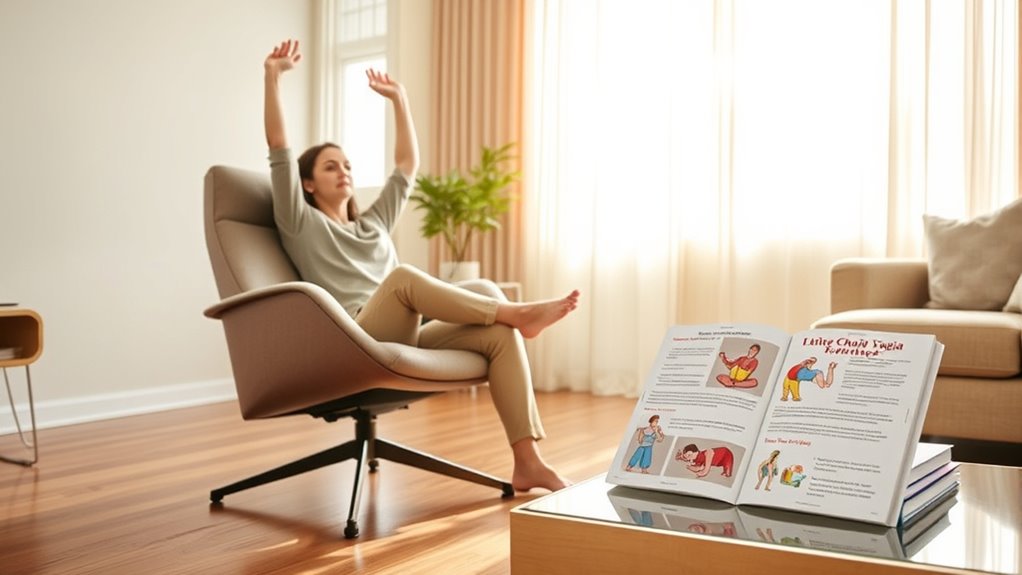
Incorporating chair yoga into your daily routine is simple if you start small and stay consistent. Begin by adding a few minutes each day, focusing on adaptive modifications to suit your comfort level. Pay attention to posture alignment during each pose to prevent strain and maximize benefits. Using proper alignment helps you engage muscles correctly and reduces the risk of injury. As you become more comfortable, gradually increase the duration or complexity of your practice. Keep a regular schedule, such as practicing in the morning or during breaks, to build a habit. Remember, consistency is key. With these tips, chair yoga can become an accessible, enjoyable part of your daily wellness routine.
Frequently Asked Questions
Can Chair Yoga Be Suitable for Seniors With Mobility Issues?
Yes, chair yoga is suitable for seniors with mobility issues because it involves seated stretches and gentle movements that are easy to perform. You can modify poses to match your comfort level, making it safe and accessible. This practice helps improve flexibility, balance, and circulation without putting stress on your joints. With regular practice, you’ll likely notice increased mobility and a boost in overall well-being.
What Types of Chairs Are Best for Practicing Chair Yoga?
Think of choosing a chair like picking the right partner for a dance; comfort and support matter. For chair yoga, your best options are office chairs with ergonomic designs that provide good back support and adjustable height. I’ve seen seniors thrive when they use sturdy, well-cushioned chairs that allow safe movement. Avoid chairs with wheels or armrests that might hinder stability, ensuring your practice remains safe and effective.
How Often Should I Do Chair Yoga for Optimal Benefits?
You should aim for chair yoga sessions 3 to 5 times a week for ideal benefits. Keep your session duration around 15 to 30 minutes, depending on your schedule and comfort. Following these frequency recommendations helps improve flexibility, strength, and relaxation. Consistency is key, so listen to your body and gradually increase session length if you feel comfortable. Regular practice boosts overall well-being and reduces stress effectively.
Are There Any Contraindications or Health Concerns to Consider?
You should consider medical contraindications and health precautions before starting chair yoga. If you have chronic conditions, recent surgeries, or mobility issues, consult your healthcare provider first. Be cautious with movements that cause pain or discomfort. Always listen to your body, avoid overexertion, and modify poses as needed. Taking these precautions guarantees you practice safely and gain the benefits without risking injury or worsening existing health concerns.
Can Chair Yoga Help With Specific Medical Conditions or Injuries?
Yes, chair yoga can help with specific medical conditions or injuries if you use appropriate adaptations. You should focus on medical condition adaptations and injury specific modifications to guarantee safety and effectiveness. Always consult your healthcare provider before starting, and listen to your body. Adjust poses as needed, avoid overexertion, and follow guidance to prevent aggravating your condition or injury. Proper modifications make chair yoga accessible and beneficial for many health concerns.
Conclusion
Now that you’ve opened the door to gentle movement, let chair yoga become your daily oasis of calm and strength. Picture each pose as a stepping stone across a peaceful pond, guiding you toward balance and relaxation. With your printable guide in hand, you’re ready to weave these stretches into your routine, turning everyday moments into a serene journey. Embrace the flow, and watch your body and mind blossom like flowers in spring.
